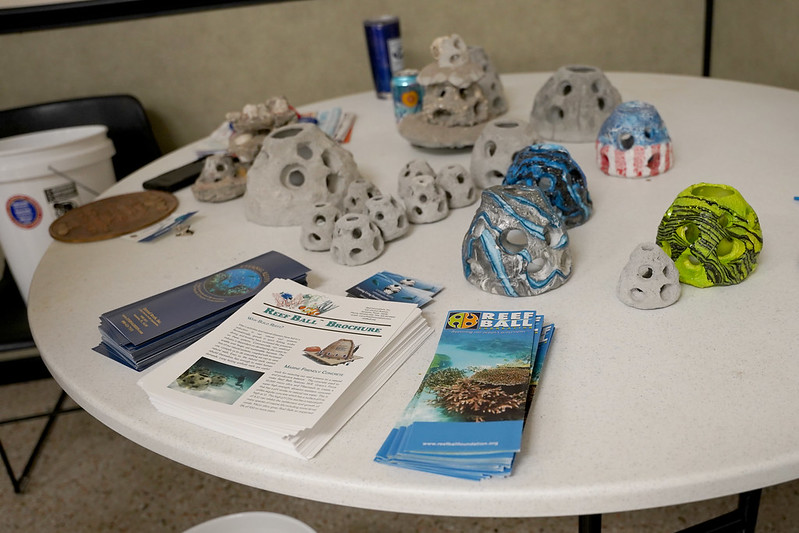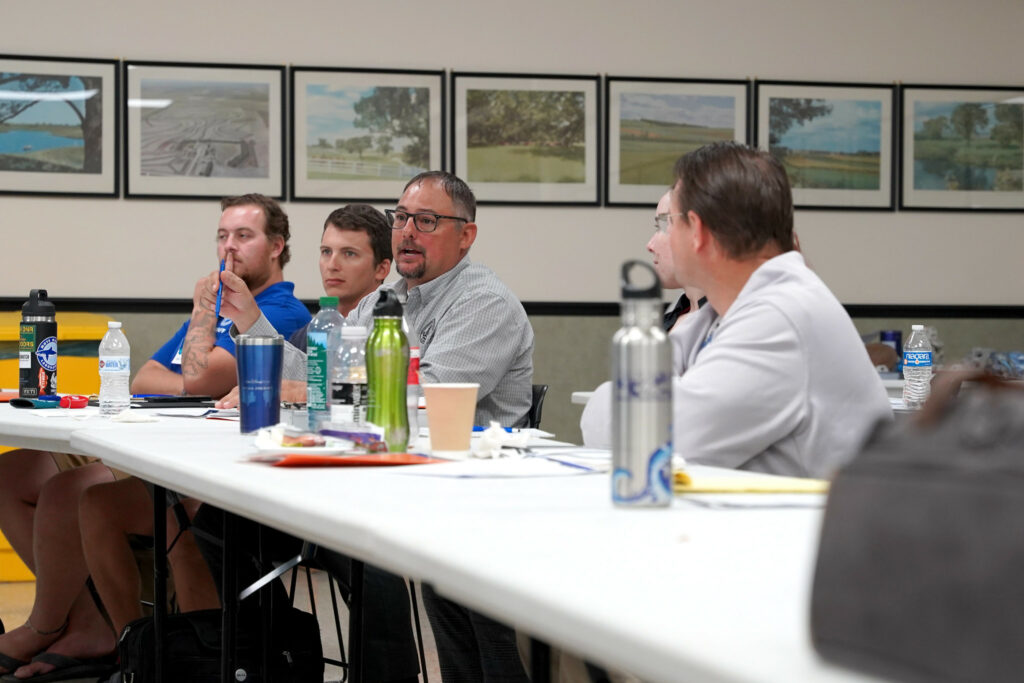
On March 8th, over 70 experts, including artificial reef manufacturers, county coordinators, regulators, wildlife managers, researchers, and recreational user groups convened in Palmetto for the regional Southwest Florida Artificial Reef Workshop.
Dr. Angela Collins from Florida Sea Grant (FSG) partnered with other FSG faculty and staff from the Florida Fish and Wildlife Conservation Commission (FWC) to organize the collaboration between public and private organizations in artificial reef development. The workshop engaged experts’ understanding of the functions of artificial reefs, fisheries management, and long-term economic and social benefits for the state.
“Sharing information, learning from each other, and discussing the pitfalls that have been resolved are critical to helping meet the goals of artificial reef development,” says FWC’s Keith Mille, the Biological Administrator for FWC’s Division of Marine Fisheries Management and Artificial Reef Program. “The work we are doing in Florida helps set a precedent for other nations as well.”
Between 2017-2022, 579 patch reefs were deployed on Florida’s coast, including 20 patch reefs in southwest Florida. A daily average of 5,600 persons in Southwest Florida use artificial reefs, generating $253 million in the region annually. Trends in the past few years have shown that artificial reefs provide species-specific habitats and protection of existing reefs while facilitating the state’s recreational economy in snorkeling, diving, kayaking, and fishing.
County and Estuary Program Perspective
Florida’s southwest coastal counties are taking unique approaches toward artificial reef developments. Artificial reef coordinators from 13 southwest Florida counties shared updates on deployments, site assessments, habitat and shoreline restoration, species monitoring, citizen science training, and opportunities for collaboration. Here are just a few highlights:
- Collier County restored 23 oyster reefs in Naples Bay, made with limestone and fossilized shells. Within 6 months, 800 oysters were counted, and 1366 in 24 months.
- Manatee County deployed its most recent reef in November 2022 called the Bridge Reef Site, consisting of 490 tons of limestone boulders. The county is working on removing seawalls and installing vegetation and reef materials for a living shoreline.
- Taylor County deployed 64 concrete cubes in 2020 and expanded the Buckeye Reef. The county conducted two feasibility assessments on inshore sites, started the permitting process for reef expansion, and trained volunteer divers for a citizen science program to identify and count fish.
Other stakeholders invested in artificial reef science in Florida include the National Estuary Programs in Tampa Bay, Sarasota, and Charlotte Harbor. All three programs have incorporated artificial reefs in their Comprehensive Conservation and Management Plans (CCMP) and Habitat Master Plan:
- Tampa Bay Estuary Program developed the Tampa Bay Nekton Index, studying the fish assemblage associated with seagrass and hard bottom habitats within Tampa Bay. The program has also facilitated a reef deployment in Manatee County and investigated the removal and enhancement of tire reefs in Pinellas County.
- Sarasota Bay Estuary Program focused on oyster and artificial reef restoration and assessed artificial reefs optimal for fish communities, finding that deep-cover reefs support juvenile gag grouper populations.
- Coastal and Heartland National Estuary Program developed online resources CHNEP Water Atlas and CCMP Connection, which provide ways for stakeholders and the public to engage with data and resources beneficial to artificial reef deployment and habitat restoration.
While counties and regional programs differ in their approach to artificial reefs, there is a cooperative effort to utilize and encourage habitats that help to sustain fisheries and support ecosystem services.
Sharing information, learning from each other, and discussing the pitfalls that have been resolved are critical to helping meet the goals of artificial reef development. The work we are doing in Florida helps set a precedent for other nations as well.
Keith Mille
Florida Fish and Wildlife Conservation Commission
Managing Fisheries and Habitats
Artificial reefs provide a habitat that attracts many marine species. As a result, artificial reefs are also attractive spots for fishermen. “Boats are visiting reefs 3-10 times more than natural reefs because of published location data,” says Dr. Chris Stallings, an associate professor of Biological Oceanography from the University of South Florida, studying the capacity of artificial reefs to support species-richness.
Researchers from FWC and Mote Marine Laboratory are also studying the effects of reef restoration and artificial habitats on fish communities using technology and available data.
Ryan Schloesser, Program Manager for Fisheries Ecology and Enhancement at Mote Marine Laboratory, provided ways his team assessed fish survival, size, movement, species, and habitat use to evaluate how fish respond to hardened shorelines.

Reef balls are a popular artificial reef module design, known to stabilize shorelines and create habitats that sustain oyster communities.
“Tidally influenced shorelines throughout Southwest Florida have a long history of being altered and hardened,” says Schloesser. “These areas historically provided nursery habitats for juvenile fish, and now they have turned into low complexity artificial structures that do not offer protection for ecologically and economically important fish. Treating hardened shorelines more like artificial reefs could help restore habitat value to our shorelines.”
Sean Keenan, an assistant research scientist at FWC-FWRI shared a long-term reef fish monitoring survey in the Gulf of Mexico which includes mapping of artificial and natural reef habitats and deployment of stereo-video camera systems.
The randomized mapping data can characterize the distribution of natural and artificial reefs by their structure and can serve as a guide for future reef deployment. To date, their research team has analyzed over 6000 camera sets, identifying, and enumerating 114 different species of fish at 1500 natural and artificial reef deployment sites in the eastern Gulf of Mexico.
All of the data collected on habitat distribution and species abundance advances sustainable fishing practices. Captain Jason Stock from Full Send Reef Habitat Inc. shared his experience with artificial reefs and fisheries management. “Artificial reefs result in sustainable harvests,” says Stock. “When species-specific habitats are easy to locate, it increases the chances of having a desired catch, while minimizing the impacts on overfished spots.”
Memorial Reefs
Reef structures are also installed for artistic, commemorative, and recreational purposes. Professor Emeritus of Oceanography at St. Petersburg College, Dr. Heyward Mathews, designed the nation’s first underwater dive memorial honoring the men and women who served in all branches of the U.S. Armed Forces.
The vision of the Circle of Heroes Veterans Reef came to fruition after Dr. Mathews utilized barges and a naval aircraft for reef structures. After the original design encountered challenges, Dr. Mathews designed a reef with 12 concrete lifesize statues of men and women in their respective branch uniforms.
Mathews specifically wanted to commemorate a statue for the U.S. Coast Guard Seaman Apprentice William R. Flores, who died while saving fellow shipmates on January 28, 1980, aboard the U.S. Coast Guard Cutter Blackthorn in Tampa Bay.
Other memorial reefs can be requested by families to honor or commemorate individuals. Frank Gidus with Coastal Conservation Association Florida reported that they have deployed 46 artificial reefs since 2012, two of which were deployed in honor of Dr. Bart Carey and former House of Representative R.Z. Sandy Safley, ten miles southwest of Dog Island. The reef memorial included ceremonial deployment, with the respective families in attendance.
Challenges
The multifunctional use of artificial reefs helps local economies, governments, and state scientists, but the implementation of artificial reefs can be complex and sometimes result in unintended consequences. Associate Professor of Fisheries and Aquatic Sciences, Dr. Ed Camp, shared how his team at the University of Florida is studying the effects artificial reefs can have not only on fish but also anglers, divers, and overall fisheries. Artificial reefs are usually justified as management actions helping fish populations and fishing. However, Camp’s research suggests there may be trade-offs.

Presentations on artifical reefs and managing fisheries prompt audience members to engage in conversation during Q&A.
“Artificial reefs can benefit fish in some ways, like growth or survival, but they seem likely to increase fishing mortality even more—by making it easier for more people to find and catch fish. The issue isn’t “attractions vs. production” with reefs—both go on. It’s a matter of which has the greater effects, and right now, it looks to us like attraction,” says Camp.
Artificial reefs are also not immune to the challenges of dynamic climate and oceanic conditions. Dive Safety Officer and Instructor of Scientific Diving Calli Johnson from Florida Gulf Coast University shared the impacts on artificial reefs after Hurricane Ian.
“Based on our survey, Hurricane Ian impacted all of the artificial reefs in Lee County, at least at 70 feet of depth, and at least 71 nautical miles away from Cayo Costa,” says Johnson. “Some of the effects on reefs include changes in reef structure, marine organisms, as well as sediment covering benthic species.”
Dr. William Seaman, the University of Florida Professor Emeritus and former Florida Sea Grant Associate Director shared his perspectives on the challenges and questions prompted by current development. “Challenges with artificial reefs include the failures of materials and on-site placement, over-harvesting, lag in comparisons to reef systems, serving as stepping stones for invasive species, and the potential for greenwashing the benefits,” says Dr. Seaman.
Fortunately, updated technology, research, and monitoring programs can help identify challenges and enhance the resilience and productivity of artificial reefs.
The Future of Artificial Reefs
The Southwest Florida Artifical Reef Workshop demonstrates the importance of utilizing a collective space to advance scientific research that will direct the design, deployment, and evaluation of artificial reefs. The regional component of the workshop allows local stakeholders to come together and discuss how environmental, economic, demographic, and even situational factors may influence artificial reef developments in their area.
The research and information sharing amongst experts can continue to expand and develop the full potential of artificial reefs as a response to emerging marine, ocean, and climate challenges.
To learn more about artificial reef research and development in the state of Florida, visit the live recording of the workshop below.